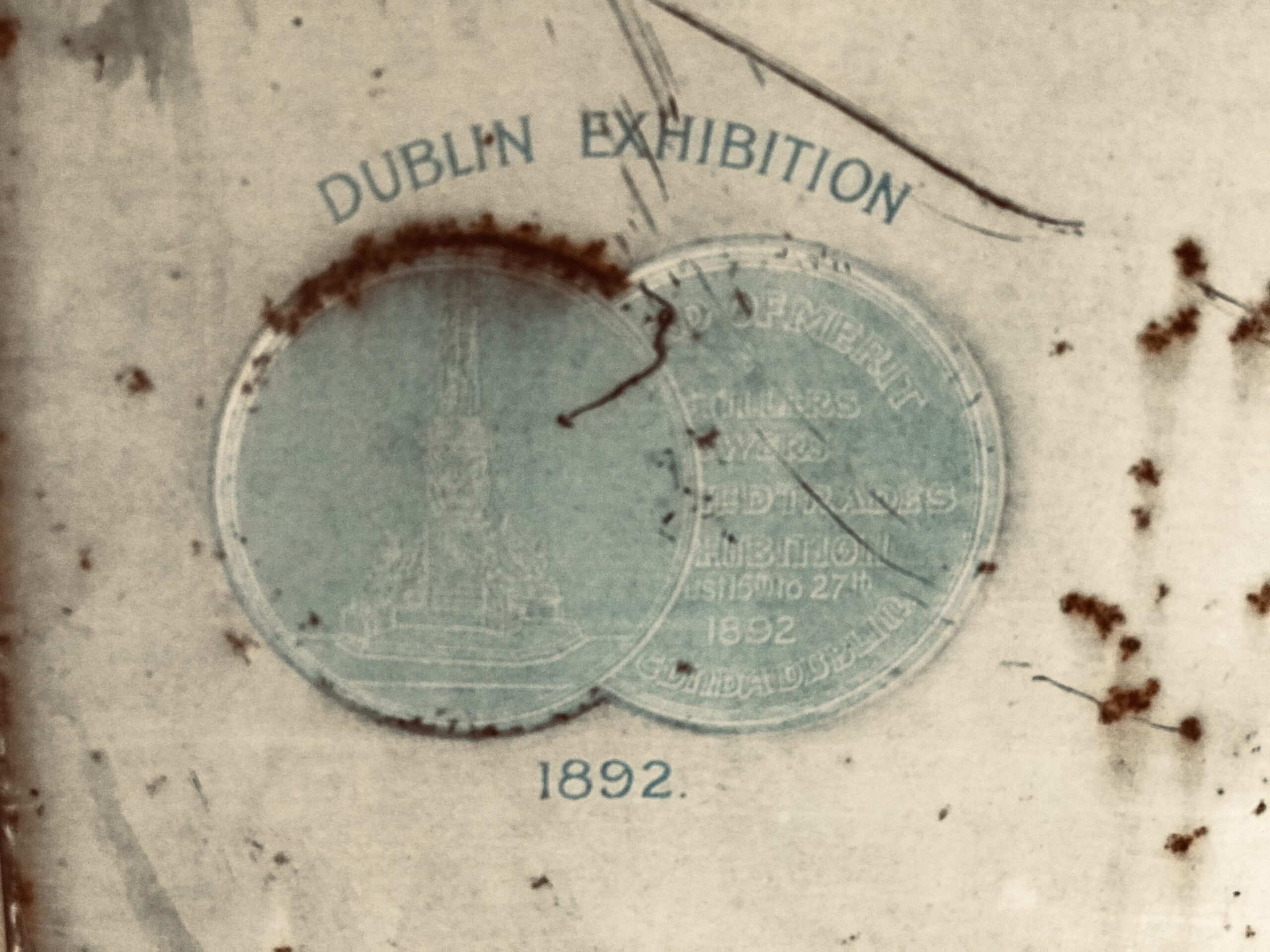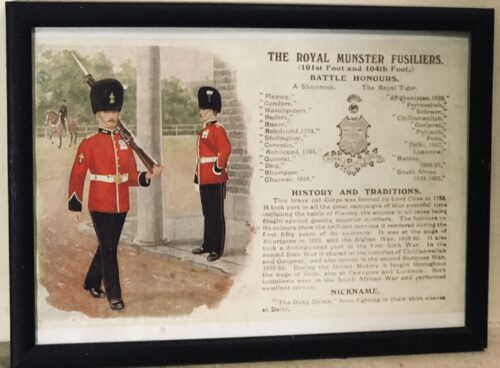Classic old tin advertising sign dating from the 1920s.Prizes won by the much lauded Murphy’s Brewery of Ladys Well,Cork are mentioned on the sign such as from the Dublin Exhibition of 1892 and its Manchester Counterpart from 1895.
40cm x 60cm Schull Co Cork
JAMES J. MURPHY

Born on November 1825, James Jeremiah Murphy was the eldest son of fifteen children born to Jeremiah James Murphy and Catherine Bullen. James J. served his time in the family business interest and was also involved in the running of a local distillery in Cork. He sold his share in this distillery to fund his share of the set up costs of the brewery in 1856. James J. was the senior partner along with his four other brothers. It was James who guided to the brewery to success in its first forty years and he saw its output grow to 100,000 barrels before his death in 1897. James J. through his life had a keen interest in sport, rowing, sailing and GAA being foremost. He was a supporter of the Cork Harbour Rowing Club and the Royal Cork Yacht Club and the Cork County Board of the GAA. James J. philanthropic efforts were also well known in the city supporting hospitals, orphanages and general relief of distress in the city so much so on his death being described as a ‘prince in the charitable world’. It is James J. that epitomises the Murphy’s brand in stature and quality of character.
OUR LADY’S WELL BREWERY

In 1854 James J. and his brothers purchased the buildings of the Cork foundling Hospital and on this site built the brewery. The brewery eventually became known as the Lady’s Well Brewery as it is situated adjacent to a famous ‘Holy Well’ and water source that had become a famous place of devotion during penal times.
THE BEGINNING

James J. Murphy and his brothers found James J. Murphy & Co. and begin brewing.
FROM STRENGTH TO STRENGTH

In 1861 the brewery produced 42,990 barrels and began to impose itself as one of the major breweries in the country.
A FRIEND OF THE POOR, HURRAH

James J. was a much loved figure in Cork, a noted philanthropist and indeed hero of the entire city at one point. The ‘Hurrah for the hero’ song refers to James J’s heroic efforts to save the local economy from ruin in the year of 1885. The story behind this is that when the key bank for the region the ‘Munster Bank’ was close to ruin, which could have led to an economic disaster for the entire country and bankruptcy for thousands, James J. stepped in and led the venture to establish a new bank the ‘Munster and Leinster’, saving the Munster Bank depositors and creditors from financial loss and in some cases, ruin. His exploits in saving the bank, led to the writing of many a poem and song in his honour including ‘Hurrah for the man who’s a friend of the poor’, which would have been sung in pubs for many years afterwards.
THE MALT HOUSE

In 1889 a Malt House for the brewery was built at a cost of 4,640 pounds and was ‘built and arranged on the newest principle and fitted throughout with the latest appliances known to modern science”. Today the Malthouse is one of the most famous Cork landmarks and continues to function as offices for Murphy’s.
MURPHY’S GOLD

Murphy’s Stout wins the Gold medal at the Brewers and Allied Trades Exhibition in Dublin and again wins the supreme award when the exhibition is held in Manchester in 1895. These same medals feature on our Murphy’s packaging today. Murphy’s have continued it’s tradition of excellence in brewing winning Gold again at the Brewing Industry International awards in 2002 and also gaining medals in the subsequent two competitions.
MURPHY’S FOR STRENGTH

Eugen Sandow the world famous ‘strongman’, endorses Murphy’s Stout: “From experience I can strongly recommend Messrs JJ Murphy’s Stout”. The famous Murphy’s image of Sandow lifting a horse was then created.
THE JUBILEE

The Brewery celebrates its 50th anniversary. On Whit Monday the brewery workforce and their families are treated to an excursion by train to Killarney. Paddy Barrett the youngest of the workforce that day at 13 went on to become head porter for the brewery and could recall the day vividly 50 years later.
SWIMMING IN STOUT

In the year of 1913 the No.5 Vat at ‘Lady’s Well’ Brewery burst and sent 23,000 galleons of porter flooding through the brewey and out on to Leitrim Street. The Cork Constitution, the local newspaper of the time wrote that “a worker had a most exciting experience and in the onrush of porter he had to swim in it for about 40 yards to save himself from asphyxiation”
JOINING UP

The First World War marked an era of dramatic change both in the countries fortune and on a much smaller scale that of the Brewery’s. On the 13 August James J. Murphy and Co. joined the other members of the Cork Employers Federation in promising that ‘all constant employees volunteering to join any of his Majesties forces for active service in compliance with the call for help by the Government will be facilitated and their places given back to them at the end of the war’. Eighteen of the Brewery’s workers joined up including one sixteen year old. Ten never returned.
THE FIRST LORRY IN IRELAND

James J. Murphy & Co. purchase the first petrol lorry in the country.
THE BURNING OF CORK

On the 11-12th December the centre of Cork city was extensively damaged by fire including four of the company’s tied houses (Brewery owned establishments). The company was eventually compensated for its losses by the British government.
MURPHY’S IN A BOTTLE

In 1921 James J. Murphy and Co. open a bottling plant and bottle their own stout. A foreman and four ‘boys’ were installed to run the operation and the product quickly won ‘good trade’.
THE FIRST CAMPAIGNS

In 1924 the Murphy’s Brewery began to embrace advertising. In the decades prior to this the attitude had been somewhat negative with one director stating ‘We do not hope to thrive on pushing and puffing; our sole grounds for seeking popular favour is the excellence of our product’.
WWII

In 1940 at the height of the London Blitz the Murphy’s auditing firm is completely destroyed. The war which had indirectly affected the firm in terms of shortages of fuel and materials now affected the brewery directly.
LT. COL JOHN FITZJAMES

In 1953 the last direct descendant of James J. takes over Chairmanship of the firm. Affectionately known in the Brewery as the ‘Colonel’ he ran the company until 1981.
THE IRON LUNG

Complete replacement of old wooden barrels to aluminium lined vessels (kegs) known as ‘Iron lungs’ draws to an end the era of ‘Coopers’ the tradesmen who built the wooden barrels on site in the Brewery for so many decades.
MURPHY’S IN AMERICA

Murphy’s reaches Americans shores for the first time winning back many drinkers lost to emigration and a whole new generation of stout drinkers.
MURPHY’S GOES INTERNATIONAL

Murphy’s Launched as a National and International Brand. Exports included UK, US and Canada. Introduction of the first 25cl long neck stout bottle.
MURPHY’S OPEN

Murphy’s commence sponsorship of the hugely successful Murphy’s Irish Open Golf Championship culminating in Colm Montgomery’s ‘Monty’s’ famous third win at ‘Fota Island’ in 2002.
MURPHY’S GOLD

Murphy’s wins Gold at the Brewing Industry International Awards a testament to it’s superior taste and quality. Indeed 2003 was the first of three successive wins in this competition.
150 YEARS OF BREWING LEGEND

The Murphy Brewery celebrates 150 years of brewing from 1856 to 2006 going from strength to strength; the now legendary stout is sold in over 40 countries and recognised worldwide as superior stout. We hope James J. would be proud.















